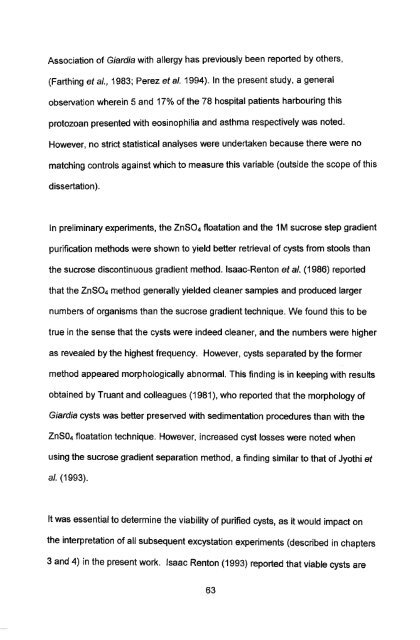in vitro culture and isoenzyme analysis of giardia lamblia
in vitro culture and isoenzyme analysis of giardia lamblia
in vitro culture and isoenzyme analysis of giardia lamblia
You also want an ePaper? Increase the reach of your titles
YUMPU automatically turns print PDFs into web optimized ePapers that Google loves.
Association <strong>of</strong> Giardia with allergy has previously been reported by others,<br />
(Farth<strong>in</strong>g et al., 1983; Perez et al. 1994). In the present study, a general<br />
observation where<strong>in</strong> 5 <strong>and</strong> 17% <strong>of</strong> the 78 hospital patients harbour<strong>in</strong>g this<br />
protozoan presented with eos<strong>in</strong>ophilia <strong>and</strong> asthma respectively was noted.<br />
However, no strict statistical analyses were undertaken because there were no<br />
match<strong>in</strong>g controls aga<strong>in</strong>st which to measure this variable (outside the scope <strong>of</strong> this<br />
dissertation) .<br />
In prelim<strong>in</strong>ary experiments, the ZnS04 floatation <strong>and</strong> the 1 M sucrose step gradient<br />
purification methods were shown to yield better retrieval <strong>of</strong> cysts from stools than<br />
the sucrose discont<strong>in</strong>uous gradient method. Isaac-Renton et al. (1986) reported<br />
that the ZnS04 method generally yielded cleaner samples <strong>and</strong> produced larger<br />
numbers <strong>of</strong> organisms than the sucrose gradient technique. We found this to be<br />
true <strong>in</strong> the sense that the cysts were <strong>in</strong>deed cleaner, <strong>and</strong> the numbers were higher<br />
as revealed by the highest frequency. However, cysts separated by the former<br />
method appeared morphologically abnormal. This f<strong>in</strong>d<strong>in</strong>g is <strong>in</strong> keep<strong>in</strong>g with results<br />
obta<strong>in</strong>ed by Truant <strong>and</strong> colleagues (1981), who reported that the morphology <strong>of</strong><br />
Giardia cysts was better preserved with sedimentation procedures than with the<br />
ZnS04 floatation technique. However, <strong>in</strong>creased cyst losses were noted when<br />
us<strong>in</strong>g the sucrose gradient separation method, a f<strong>in</strong>d<strong>in</strong>g similar to that <strong>of</strong> Jyothi et<br />
al. (1993).<br />
It was essential to determ<strong>in</strong>e the viability <strong>of</strong> purified cysts, as it would impact on<br />
the <strong>in</strong>terpretation <strong>of</strong> all subsequent excystation experiments (described <strong>in</strong> chapters<br />
3 <strong>and</strong> 4) <strong>in</strong> the present work. Isaac Renton (1993) reported that viable cysts are<br />
63
















